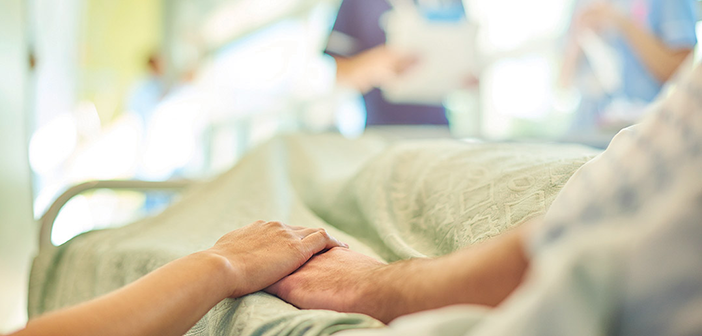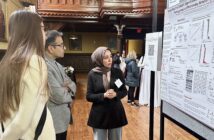A personal tragedy reminds a student to see the people behind those coveted teaching cases.
Bzzzz… the patient’s phone vibrates on the small desk. My preceptor is searching for the new labs in the chart. The patient takes this as an opportunity to peer down.
“Two new Eastern equine encephalitis cases,” the patient says, looking up at me. My stomach drops. “The first one died a week ago. News said he was from right here in Warwick, too.”
I nod along. “They sprayed the area this weekend,” I say. “Hopefully that helps.”
****
Two weeks earlier. It’s early September, and I’m spending my free weekend catching up with my best friend. My phone buzzes, I look down, surprised to see that my cousin is calling. She has news about our cousin from Warwick. “You know that EEE story all over the news …” she begins.
****
The next patient comes into clinic for a routine follow-up, but she’s preoccupied with worries about the virus known as “triple-E.” She asks me to examine all bumps and bruises, review symptoms, and if I know anything about the Warwick case.
The virus was grabbing headlines across the Northeast last summer and fall, as mosquitoes, and then humans, tested positive for the rare yet deadly disease. It starts off with flu-like symptoms—headache and high fever—and rapidly progresses as the brain swells and patients exhibit more severe neurological symptoms including seizure, hallucinations, and coma. About a third of people with EEE die; survivors can suffer brain damage and paralysis.
As summer gave way to fall, frightened parents kept kids inside. Night football games were rescheduled and canceled. Towns announced aerial spraying to kill the infected mosquitoes. By November, when the first frost hit, the CDC had received reports of 36 confirmed cases for 2019, including 14 deaths. Three cases were in Rhode Island. The first case was my cousin.
My cousin was the man who was there to build up my self-esteem after my father left. He was the person who made me smile when it was hard to, and who was always unapologetically himself.
He lived in Warwick. He was a dad, a brother, an uncle, a coach, a fighter …
He was only 58.
He was much more than the EEE case.
I say nothing about the case to the patient. Instead, I calmly reassure her that the bumps she is concerned about are blisters from her new shoes and that it is unlikely she will get EEE. We move on to discuss the reason for her follow-up today.
****
I escape after clinic to Neurology Happy Hour, eager to chat more about the field. As a student, and thus assumed to be well versed in social media, the doctors ask me about what I’d want to see posted on their residency program’s Instagram account.
“I like learning about medical cases on the accounts I follow,” I reply without much thought.
“We could post about our triple-E case,” one of the docs eagerly chimes in.
****
Wednesday didactics happened to coincide with flu clinic, so classmates I haven’t seen in a while are at the Medical School. I approach a circle of friends standing in line to get flu shots. We trade rotation tips and talk about exciting cases we’ve gotten to see so far while we wait.
“I saw the guy with triple-E last week!” one friend shares.
I excuse myself, blaming didactics for my abrupt exit.
****
It’s another day at the clinic. I knock on the door and enter. A man, middle aged, presents with general fatigue and a headache that he reports as 8 out of 10 on the pain scale. He says he works outside in the early mornings and evenings. My heart races. Could this be EEE? I don’t want to exclude it from the differential, but if I include it will the residents think I am being extreme? I think of the medical proverb, “When you hear hoofbeats, look for horses, not zebras.”
I decide to include it.
“If it was triple-E, not much we would be able to do,” the resident replies.
I agree.
****
Throughout our medical training, it can feel like we carry around a trainee passport. We eagerly fill each page with stamps of new, exciting cases, cherishing the “zebras” we manage to collect along the way. Often in our practice of recording and sharing these experiences, however, we lose sight of the personal.
Throughout the last few weeks on my family medicine clerkship, I was unable to escape the personal impact of the EEE case, with daily reminders of my loss coming from patients, peers, residents, attendings, and the local news. It made me reflect and think more deeply about my own trainee passport. I thought about the people behind each stamp, how the families I worked with are doing now, and how I can be more thoughtful moving forward in my own interactions.
I also have thought more about the impact of sharing these cases with my peers. While my personal experience, with its publicity, may be on the extreme end, we never truly know who may be affected by the stories we share.
I hope that my cousin will be immortalized in the trainee passports of the medical professionals who saw him. I know he will live on in my own—as a strong, proud father and a dojo master. I hope the people who cared for my cousin will also find time to reflect on the lessons he taught them. I hope that they, too, record a piece of his persona, and not just his diagnosis.
Living through the personal and the medical behind my own EEE stamp, I have become more grateful for the opportunity to support patients during intimate and life-changing periods of their lives. While I will continue to add stamps to my trainee passport, I’m now more cognizant of their value.
Thank you to all the patients who have contributed to my passport and who have truly taught me medicine. You, too, will never be forgotten.




